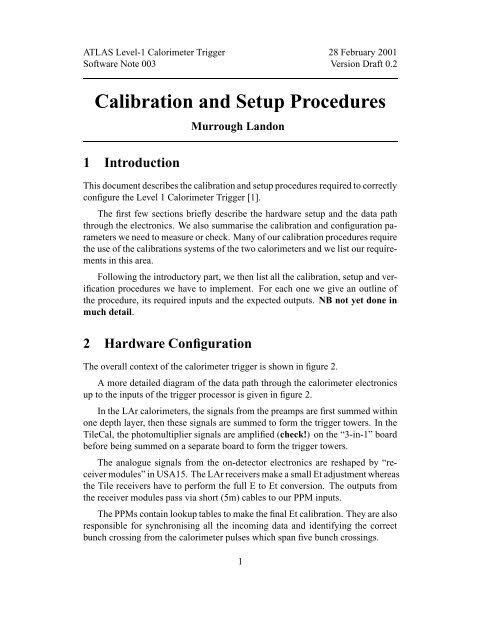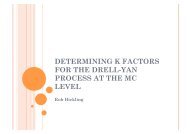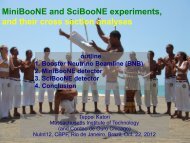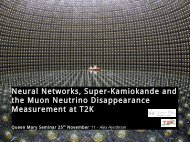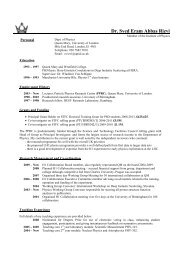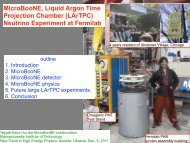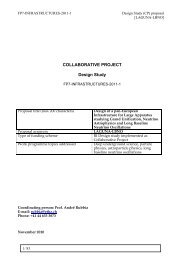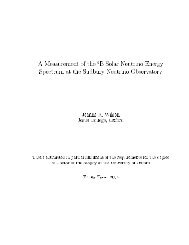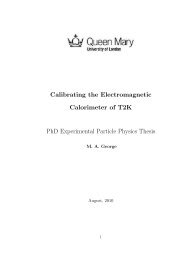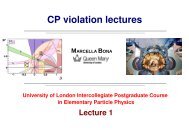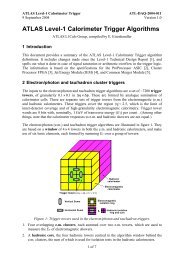Calibration and Setup Procedures
Calibration and Setup Procedures
Calibration and Setup Procedures
You also want an ePaper? Increase the reach of your titles
YUMPU automatically turns print PDFs into web optimized ePapers that Google loves.
ATLAS Level-1 Calorimeter Trigger 28 February 2001Software Note 003 Version Draft 0.2<strong>Calibration</strong> <strong>and</strong> <strong>Setup</strong> <strong>Procedures</strong>1 IntroductionMurrough L<strong>and</strong>onThis document describes the calibration <strong>and</strong> setup procedures required to correctlyconfigure the Level 1 Calorimeter Trigger [1].The first few sections briefly describe the hardware setup <strong>and</strong> the data paththrough the electronics. We also summarise the calibration <strong>and</strong> configuration parameterswe need to measure or check. Many of our calibration procedures requirethe use of the calibrations systems of the two calorimeters <strong>and</strong> we list our requirementsin this area.Following the introductory part, we then list all the calibration, setup <strong>and</strong> verificationprocedures we have to implement. For each one we give an outline ofthe procedure, its required inputs <strong>and</strong> the expected outputs. NB not yet done inmuch detail.2 Hardware ConfigurationThe overall context of the calorimeter trigger is shown in figure 2.A more detailed diagram of the data path through the calorimeter electronicsup to the inputs of the trigger processor is given in figure 2.In the LAr calorimeters, the signals from the preamps are first summed withinone depth layer, then these signals are summed to form the trigger towers. In theTileCal, the photomultiplier signals are amplified (check!) on the “3-in-1” boardbefore being summed on a separate board to form the trigger towers.The analogue signals from the on-detector electronics are reshaped by “receivermodules” in USA15. The LAr receivers make a small Et adjustment whereasthe Tile receivers have to perform the full E to Et conversion. The outputs fromthe receiver modules pass via short (5m) cables to our PPM inputs.The PPMs contain lookup tables to make the final Et calibration. They are alsoresponsible for synchronising all the incoming data <strong>and</strong> identifying the correctbunch crossing from the calorimeter pulses which span five bunch crossings.1
Level 1 Calorimeter TriggerContext diagramLAr CalorimeterTile CalorimeterOnlineSoftwareDCSL1 CaloTriggerTTCBUSYLevel 2CTPReadoutL1Calo context diagram.3 Configuration ParametersThe complete configuration of the trigger processor requires a large number ofparameters. Some of these are derived from trigger menu choices. However thebulk of them must be determined by calibration.The complete list of parameters for each type of module is described in [3].Below we summarise the main calibration parameters.Clocks: delays for the TTCrx output clock(s), possibly also some otherTTCrx parameters.Readout: the L1Accept latency for each readout pipeline memory.Energy calibration: the lookup tables in the PPMs.BCID: the FIR filter coefficients <strong>and</strong> saturated BCID thresholds.Voltage levels: the FADC zero level <strong>and</strong> external BCID disriminator thresholds.Input timing: the FADC strobe phase <strong>and</strong> synchronisation delays.2
Level 1 Calorimeter TriggerElectronics ChainBarrel <strong>and</strong> EMEC FCAL HECTilesMotherboard(cold)Motherboard& Preamp (cold)Photomultiplier<strong>Calibration</strong>Board<strong>Calibration</strong>TriggerFront End Board(Preamp, Shaper<strong>and</strong> Layer Sums)Tower BuilderBoard (EM)ReceiverStation (LAr)Front End Board(Shaper<strong>and</strong> Layer Sums)Tower DriverBoard (Had)Barrel/Endcapsumming <strong>and</strong>cable patchingTile/HECcable patching?3-in-1BoardsTriggerSumsReceiverStation (Tile)ChargeInjectionLaser <strong>Calibration</strong>System<strong>Calibration</strong>TriggersPreProcessorModule (PPM)PreProcessorModule (PPM)BackplaneFanoutCluster ProcessorModule (CPM)Jet/EnergyModule (JEM)BackplaneFanoutCable link tosystem CMMCommon MergerModule (CMM)Common MergerModule (CMM)Cable link tosystem CMMCTPCalorimeter trigger electronics chain.3
Internal timing: clock <strong>and</strong> strobe phases for all internal links.4 External Requirements4.1 Calorimeter <strong>Calibration</strong> SystemsWe will need to use both LAr <strong>and</strong> Tile calibration systems. In the Tile calorimeterthere is a choice of three, though only two are likely to be of any use to us, <strong>and</strong>we will most probably only use one of those.We have the following requirements on the calorimeter calibration systems.Granularity: we must be able to pulse each trigger tower separately. Wemust also be able to effectively pulse each component cell forming a triggertower. This may be done either by the calibration system itself or bydisabling inputs to the trigger tower sums.Energy: we must be able to receive pulses with a range of different energiesboth within our dynamic range (0–255GeV) <strong>and</strong> beyond it (to studysaturated pulses).Timing: the timing of the calibration pulses must be the same timing –within a small tolerance (about 1ns?) – of real particles.Synchronous: it would be desirable to be able to simultaneously pulse differentareas of the calorimeter simulaneously (which may be in differentTTC partitions). Eg to see signals summed across the barrel/endcap transitionetc.Initial discussions with the calorimeter groups suggest that at least the firstthree main requirements can be met by the LAr calibration system (havent checkedthe last) <strong>and</strong> also by the TileCal charge injection system. The TileCal laser calibration– I think – can only pulse all cells at once.4.2 Online SoftwareThe run control system [2] should allow us to operate a calibration procedure ina convenient fashion. This means the ability to start a calibration run <strong>and</strong> theniterate the following steps: take a few events, pause the system automatically,stop triggers temporarily, change some parameter throughout the system, restarttriggers <strong>and</strong> resume data taking. After a specified number of iterations, the runshould stop automatically.4
Stepping through a sequence of parameters in a single run is probably moreconvenient for analysing the data in a single monitoring process than a sequenceof runs which have to be analysed separately <strong>and</strong> their data combined afterwards.To some extent though, we will have to operate in the same way that eachcalorimeter chooses to run. Hopefully they will not be too different from eachother.5 Summary of <strong>Procedures</strong>The detailed procedures are listed in the appendix. This section gives a briefoverview of the most important aspects.5.1 Energy <strong>Calibration</strong>Every channel in the PPMs contains a 1024 entry lookup table (LUT) for the energycalibration. This can be filled by downloading all 1024 values. Alternatively,if the calibration is linear, the PPrASIC can fill the LUT itself, given an offset(pedestal) <strong>and</strong> a slope.A coarse Et correction is also performed in the LAr receiver modules to correctfor some gain steps in the front end electronics. The Tile receivers will howeverdo the full Et conversion as the Tile front ends make no Et correction at all.5.2 Timing <strong>Calibration</strong>sThe main timing calibration is the coarse <strong>and</strong> fine timing of the input signals tothe PPMs: ie FADC strobe phase <strong>and</strong> clock tick delay.In addition to this, there are a number of internal timing setup procedures foreach of the links between modules: PPM-CPM, PPM-JEM, CPM-CMM, JEM-CMM, CMM-CMM, CMM-CTP.5.3 BCID <strong>Calibration</strong>The pulse shape for every channel has to be measured to derive the coefficientsfor the matched filter. Thresholds for the satured pulse algorithm also have to bedetermined.5.4 Integrity ChecksWe must check that all input <strong>and</strong> internal cabling is correctly wired <strong>and</strong> functioningwithout faults. This includes all cabling from calorimeter cells through5
calorimeter electronics, receiver modules to PPMs; all internal cabling, ie the realtime data paths mentioned in the timing section plus those for readout <strong>and</strong> ROIdata, ie PPM-PPROD, CPM-CPROD, CMM-CPROD, JEM-CPROD, PPROD-ROS, CPROD-ROS, CPROD-ROIB.6
A<strong>Calibration</strong> of Input SignalsThis section covers all aspects related to our input signals. This mostly means thePPM inputs. However, although not strictly our domain, some calibrations <strong>and</strong>checks of the trigger summing <strong>and</strong> shaping chain in the calorimeter electronicscan best be done via the PPMs.A.1 Relative Calorimeter Cell TimingIn both calorimeters, several cells are summed to form a single trigger tower. Inprinciple the cable paths from each cell to the summing boards should be equalto within our required tolerances. Nevertheless we will want to check that this isindeed the case.Procedure: use calorimeter calibration system. Arrange to pulse one cell inputper summing board at a time; other cells in the same summing board are eithernot pulsed or masked off. Read a sample of events for each cell from the PPMs.Iterate over the cells in each summing board. All summing boards in the systemcan be checked simultaneously. NB slightly different procedures may be requiredfor LAr <strong>and</strong> Tile calorimeters?A.2 Timing of Barrel/Endcap SummingTowers from the LAr Barrel <strong>and</strong> Endcap in the overlap region are summed in theReceiver modules. Since the cable paths from Barrel <strong>and</strong> Endcap are different,there may be a latency different of several bunch crossings between them. Thislatency must be determined for each pair of signals to be summed.Procedure: use calorimeter calibration system. Pulse Barrel <strong>and</strong> then Endcapseparately, measure relative timing of signals arriving (via the Receivers) at thePPMs. Ideally we would then pulse Barrel <strong>and</strong> Endcap partitions simultaneously<strong>and</strong> checked the summed pulses. A single energy within the trigger dynamic rangeshould be sufficient.A.3 Timing of Tile Overlap SummingThe TileCal barrel <strong>and</strong> extended barrel both include towers covering 0.8–1.0 ineta. In the barrel these will be summed in the receiver modules to form the towerat 0.8–0.9, in the extended barrel they will form the tower at 0.9–1.0. It is hoped(check this!) that equal length cables in the TileCal electronics drawers will ensurethat each pair of signals to be summed are in time with each other. This7
must be checked. Q: what do we do if its wrong? Do we anticipate delays in thereceiver stations?Procedure: use calorimeter calibration system. Pulse 0.8–0.9 <strong>and</strong> 0.9–1.0 towersseparately <strong>and</strong> compare their timings at the PPMs. Ideally we would then pulseboth towers simultaneously <strong>and</strong> checked the summed pulses. A single energywithin the trigger dynamic range should be sufficient.A.4 Latency of PPM InputsSignals from the calorimeters will arrive at the PPM inputs with varying latency.The latency (whole clock ticks) needs to be determined for every tower.Procedure: use calorimeter calibration system. PPMs can read up to 5 bunchcrossings of data (unless we can freeze their pipelines?). This is probably lessthan the variation in timing at least between Barrel <strong>and</strong> Endcap, EM <strong>and</strong> Hadronicsections. So we need to scan the 5 bunch crossing frame: read a few events,change the readout frame, iterate. Determine which frame contains the pulse foreach tower <strong>and</strong> the latency within that frame.A.5 Timing of FADC Strobe PhaseThe calorimeter signals arriving at the PPM inputs will have varying phase withrespect to the LHC clock. This phase (within one clock cycle) needs to be determinedfor every tower. The pulse covers about 5 clock cycles. The aim is set theFADC strobe of the central cycle at the peak of the pulse. Q: what is the requiredtiming margin?Procedure: use calorimeter calibration system. Assume the latency (wholeclock ticks) has already been determined (A.4). Read a few events, adjust theFADC strobe by 1ns, iterate. Determine which strobe timing gives the maximumpeak value <strong>and</strong> most central pulse shape. Or something like that?A.6 <strong>Calibration</strong> of Unsaturated BCID ParametersThe unsaturated BCID algorithm uses a “matched filter”, ie the filter parameterscorrespond roughly to the pulse shape. The pulse shape must be measured forevery tower. Reliable identication of the bunch crossing requires that the shape beindependent of energy. This must be checked.Procedure: use calorimeter calibration system. Assume the latency <strong>and</strong> FADCstrobes have already been determined (A.4,A.5). Read a few events, measure8
pulse shape, change calibration pulse energy (within trigger dynamic range), iterate.Q: do you get a better measurement of the shape by also scanning the FADCstrobe timing? Q: efficieny of BCID as a function of FADC strobe mistiming alsoneeds to be measured.A.7 <strong>Calibration</strong> of Saturated BCID ParametersFor saturated pulses (above about 255GeV) a different BCID algorithm is used.This applies two thresholds to the rising edge of the pulse. Safe values for thesethreshold need to be found for every tower. Also the threshold at which the saturedalgorithm should be used in preference to the unsaturated algorithm.Procedure: use calorimeter calibration system. Assume the latency <strong>and</strong> FADCstrobes have already been determined (A.4,A.5). Read a few events, measurepulse shape, change calibration pulse energy (above trigger dynamic range), iterate.A.8 <strong>Calibration</strong> of External BCID ParametersThe analog input daughtercards on the PPMs also make provisional for an analogue“external BCID” signal based on a discriminator. The threshold for thisneeds to be determined for each channel.Procedure: use calorimeter calibration system. Similar to above (A.7)?A.9 Energy <strong>Calibration</strong>An Et correction is applied to LAr signals in the receiver stations. The TileCalreceivers also convert raw energy signals to Et. A further refinement <strong>and</strong> FADCpedestal subtraction is made in the PPM lookup tables. All these settings need tobe determined for each channel.Procedure: use calorimeter calibration system. Maybe also full calorimeterreadout data from calorimeter DAQ partitions.Presumably we first try to tune the Et calibration as well as possible withwhatever analogue facilities are available in the receiver stations, then refine itusing the PPM lookup tables. Iterative optimisation?9
BInternal Timing <strong>Setup</strong>This section deals with the calibration <strong>and</strong> setup of the links between variouscomponents of the trigger processor.All towers should be aligned in time at the PPMs <strong>and</strong> thereafter the cables toother parts of the system should all be the same length. However there may besmall differences which will need adjustment - <strong>and</strong> certainly need to be checked.B.1 PPM to CPM Cable LinksThe Serialisers on the CPMs can strobe the incoming LVDS data on one of four6.25ns phases within the LHC clock cycle. There is also an optional one tickdelay for further synchronisation. The best phase, <strong>and</strong> whether the extra delayis required, must be determined for each tower. The Serialisers themselves canautocalibrate the phase, however the delay must be found by comparison withother Serialisers.Procedure: use playback data from the PPMs. Load the PPM playback memorieswith a repeating 0xAA,0x55 pattern to ensure adequate transitions. Synchronouslystart playback from all PPMs. Switch all CPM Serialisers into calibrationmode, wait for all Serialisers to indicate that calibration is complete. Switchout of calibration mode <strong>and</strong> stop PPM playback. Read all chosen phases. Comparethe data read from each channel of a given CPM to see if any of them requirethe extra delay (all should have either 0xAA or 0x55 on the same tick).The board clock (ie TTCrx ClkDes1) may need to be adjusted to optimise thechoice of phases <strong>and</strong> delays for the whole board. This may need to be done incommon across the whole CPM crate to avoid problems with backplane transmission?Q: what is the tolerance for clock phase differences between boards in thesame crate.B.2 PPM to JEM Cable LinksThe Input FPGAs on the JEMs use a similar synchronisation scheme as the CPMSerialisers.Procedure: similar to that for the CPMs (B.1).B.3 CPM to CPM Backplane LinksEach CPM sends <strong>and</strong> receives data at 160MHz from its two neighhours. TheCPchips on each CPM include a calibration mode to determine the correct phaseof the 40MHz clock to demultiplex the 160MHz data stream.10
Procedure: use the autocalibration mode of the CPM Serialisers <strong>and</strong> CPchips.Assume the CPM board clock has been set to its optimal value (B.1). Switch allSerialisers on all CPMs in the crate into backplane calibration mode. Switch allCPchips into autocalibration mode. Wait for all CPchips to indicate that autocalibrationis complete. Switch CPchips <strong>and</strong> Serialisers out of calibration mode. Readthe calibrated phases from all CPchips.B.4 JEM to JEM Backplane LinksEach JEM sends <strong>and</strong> receives data at 80MHz from its two neighhours. Unlike theCPchips, no special autocalibration mode is foreseen in Jet FPGA. Track lengthson the JEM are calculated such that the data will be received correctly - assuming,presumably that all JEM board clocks are synchronised throughout the crate?Procedure: none required? What about checking it though?B.5 CPM to CMM Backplane LinksEach CPM sends parallel hit multiplicities at 40MHz to the two CMMs in the samecrate. Due to different backplane track lengths there will be a few ns skew betweenthe incoming signals (plus any phase differences among CPM board clocks). Thebest phase to strobe all the incoming data on the CMM must be determined.Procedure: use CPM playback memories. Assume all CPM timings have beenset correctly (B.3). Load suitable patterns in the Serialiser playback memories.Synchronously start playback from all CPMs in the crate. Read a few events,change the CMM board clock phase, iterate. Determine the best clock phase.B.6 JEM to CMM Backplane LinksThe JEM to CMM communication is similar to that between CPM <strong>and</strong> CMM.Procedure: similar to that for CPM to CMM links (B.5).B.7 CMM to CMM Cable LinksOne CMM in each of the Cluster, Jet <strong>and</strong> Energy processor chains acts as thesystem CMM, summing the results arriving at 40Mhz on parallel cable links fromthe other crates. The phase for strobing the incoming data from other CMMsneeds to be determined (or at least checked).Procedure: use CMM playback memories.11
B.8 CMM to CTP Cable LinksEach system CMM sends its combined data to the CTP. The latency <strong>and</strong> phase ofthe data arriving at the CTP has to be measured. This is the responsibility of theCTP group, but clearly requires data from the CMMsProcedure: use CMM playback memories.12
CIntegrity ChecksThis section discusses the procedures for checking the integrity of the system.C.1 Tower FormationIn all the calorimeters, trigger towers are formed by summing several calorimetercells. In many cases, the modularity of the calorimeters <strong>and</strong> their electronicspreclude gross mistakes. There may be cases (check!) where the possibility ofcabling errors exists such that cells are summed into the wrong tower.Checking this with the calorimeter calibration systems does however requirethat the the calibration system is correctly cabled... Matching errors may be difficultto detect.C.2 Towers to PPMs: CablingDepending on the calorimeter, between 7 <strong>and</strong> 16 towers are grouped into eachcable from the detectors to the receivers <strong>and</strong> thence to the PPMs. In principle(check!) this is fixed in the on detector electronics, but the trigger processorsdepend on this grouping being correct, so it must be checked. The bulk cablingmust also be verified.Procedure: use calorimeter calibration systems. Pulse a single tower at a time(or well separated groups of towers?), read a few events, check that the signal(s)are seen in the correct channel in the correct PPM. Iterate over all towers in thesystem.Ideally, for complete confidence, the iterations should be done one tower ata time at least once at initial installation. Thereafter some more parallel checkscould be repeated after any intervention in the cabling.C.3 Towers to PPMs: CrosstalkWe need to measure the level of cross talk among, most probably, the channelswithin one cable connector.Procedure: use calorimeter calibration systems. Pulse a single tower in eachcable/connector at a time, read a few events, measure the cross talk seen in adjacentchannels. Iterate over all towers in the system.13
C.4 Towers to PPMs: Analogue NoiseWe presumably need to measure the level of analogue noise.Procedure: not sure.C.5 Towers to PPMs: ReflectionsThe signal cables from the calorimeter are up to 70m long. There are also othercable links at each end. Presumably the analogue electronics is designed to minimisereflections, but this should be checked.Procedure: use calorimeter calibration systems. Pulse all towers, read a fewevents. Check signal shape for reflections close in time. Shift PPM readout framea few ticks later <strong>and</strong> iterate, looking for signals significantly later in time. Reflectionsin the signal cables from the front ends would arrive after about 20–30bunch crossings. <strong>Calibration</strong> triggers should be much less frequent than this interval.NB: if PPM pipelines can be frozen this procedure could be done as a singleshot capturing up to 256 timeslices at once.C.6 PPM to CPM CablingEach PPM sends the bulk of its tower data to one CPM, but additionally fans outa few towers to a CPM in each neighbouring phi quadrant. Each LDVS cablegroups four channels (eight BCMuxed towers) so the number of separate cables islarge <strong>and</strong> the potential for miscabling is high.Procedure: use the PPM playback memories. Load suitable test patterns in allPPMs: eg alternate ticks could contain coded crate+module (3 bits + 4 bits) <strong>and</strong>channel numbers (6 bits). Read a few events from the CPMs <strong>and</strong> check that eachchannel is receiving data from the correct PPM. NB this needs to be done withBCmux disabled: first transmit the first tower of each BCmux pair, then repeat theprocedure for the second tower. The disabling of BCmux <strong>and</strong> selection of BCmuxchannels must be done at both PPM <strong>and</strong> CPM ends.C.7 PPM to JEM CablingAs with the CPM data, each PPM sends the bulk of its jet cell data to one JEM, butadditionally fans out a few jet cells to a JEM in each neighbouring phi quadrant.Each LDVS cable transmits four jet cells each of which is summed from four inputtowers.14
Procedure: use the PPM playback memories. Load suitable test patterns inall PPMs, read a few events from the JEMs <strong>and</strong> check that each channel is receivingdata from the correct PPM. Although the playback memories contain theunsummed tower data, the same pattern for the CPMs (section C.7) can be usedfor the JEMs.C.8 CP <strong>and</strong> JEP BackplanesAs part of the processor crate backplane acceptance tests, the correct wiring ofthe CP <strong>and</strong> JEP crate backplanes must be checked. It is envisaged that both theCPchip <strong>and</strong> the Jet FPGA will have a firmware mode which allows a large volumeof data incoming over the backplane to be captured for subsequent readout.Procedure: use the CPM/JEM playback memories <strong>and</strong> alternate versions ofthe CPchip <strong>and</strong> Jet FPGA algorithms. Load suitable test patterns <strong>and</strong> thresholdsin all CPMs/JEMs, read a few events from the CPMs/JEMs <strong>and</strong> CMMs <strong>and</strong> checkthat each channel of each module is receiving data from the correct originatingchannel <strong>and</strong> module.C.9 CMM to CMM CablingData from each crate CMM is taken by cable to a single crate CMM acting as thesystem CMM. There are only a few such cables which can be checked by h<strong>and</strong>.Nevertheless an automated procedure is useful to check for damage to the cables.Procedure: use the CMM playback memories. Load suitable test patterns <strong>and</strong>thresholds in all CMMs, read a few events from the system CMMs <strong>and</strong> check thateach channel is receiving data from the correct originating module.C.10 CMM to CTP CablingFour system CMMs send their combined data to the CTP which will probably liveon the floor below. We must check that this cabling is correct. Also, since thisis the interface between two systems, some way of checking the ordering of bitswithin each cable is probably desirable.Procedure: use the CMM playback memories. Load suitable test patterns <strong>and</strong>thresholds in all CMMs, read a few events from the CTP <strong>and</strong> check that eachchannel is receiving data from the correct originating module, <strong>and</strong> that both CMM<strong>and</strong> CTP are using the same bit numbering.15
C.11 Pipeline Bus BackplaneReadout of data from the PPMs to the PPROD is via the custom pipeline busbackplane in the PreProcessor crates. This consists partly of PCB <strong>and</strong> also someflat cable connections. We should have a procedure to verify that the pipeline busis working correctly.Procedure: use the PPM playback memories. Load suitable test patterns <strong>and</strong>thresholds in all PPMs, read a few events from the PPRODs <strong>and</strong> check that eachchannel is receiving valid data from the correct originating module.C.12 Glink cables to CPRODsReadout of data from the CPMs, JEMs <strong>and</strong> CMMs is via Glink cables to theCPRODs. The Glink data packets from these modules do not themselves identifythe originating module. The CPROD firmware is expected to blithely encode themodule addresses of incoming data on the basis of the Glink input number. It isimportant that the correct cabling of the Glink inputs is checked.Procedure: use the CPM, JEM <strong>and</strong> CMM playback memories. Load suitabletest patterns <strong>and</strong> thresholds in all CPMs, JEMs <strong>and</strong> CMMs, read a few events fromthe CPRODs <strong>and</strong> check that each Glink input is receiving data from the correctoriginating module.C.13 PPROD <strong>and</strong> CPRODs to the ROSEach ROD sends its data to the DAQ Readout System (ROS) on one Slink connection.Although each ROD packet will uniquely identify its source ROD, weshould check that the physical connections are actually the expected ones. Thiswill be required for correct subpartitioning of the system for tests.Procedure: use the ROD playback memories. Load suitable Slink packets intothe RODs, read a few events from the ROS <strong>and</strong> check that each Slink connectionis as expected.C.14 CPRODs to the ROIBThose of the CPRODs which process ROIs will send their formatted ROI packetsvia Slink connections to the ROI builder (ROIB). Although the ROI packets donot uniquely distinguish between different kinds of ROI, the packets will containthe source ROD identifier, so the ordering of cables at the ROIB inputs may notbe important (check). Anyway it can be simply checked.16
Procedure: use the ROD playback memories. Load suitable Slink packets intothe RODs, read a few events from the ROIB <strong>and</strong> check that each Slink connectionis as expected.17
DFunctionality ChecksThis section discusses the procedures for verifying that the whole system behavescorrectly as a trigger!D.1 Simulation: Digital InputsIn ATLAS, before real data is available, the only sources of data for the wholetrigger system will be the calorimeter calibrations systems <strong>and</strong> the PPM playbackmemories. The former is not really suitable for generating data which looks likereal Physics.Procedure: use the PPM playback memories. Generate a lot of test vectorscontaining physics events, load these into the PPMs, run the system for a whileletting it generate triggers, check that the correct events are triggered <strong>and</strong> that thecorrect data is seen at all stages of the processor.D.2 Simulation: Analogue InputsAt the slice tests, we have the possibility of feeding our own analogue pulses intothe PPMs. Some simulation of physics like clusters might be possible. Schemeswhich permit a large volume of data have been discussed (ie many more than the256 time slices of the PPM playback memories).Procedure: similar to the above (D.1).D.3 Simulation: SubsystemsParts of the complete system can also be tested <strong>and</strong> simulated in isolation.18
EOther StuffWhat is unclear, what have I forgotten...Energy calibration: receivers vs PPM LUTsFADC pedestalAnalogue noiseetc?19
References[1] ATLAS Level 1 Calorimeter Trigger: home pagehttp://hepwww.pp.rl.ac.uk/Atlas-L1[2] ATLAS Online Software Run Control componenthttp://atddoc.cern.ch/Atlas/DaqSoft/components/runcontrol[3] Configuration Data for the ATLAS Level 1 Calorimeter Trigger (ATL-DA-EP-02)http://edmsoraweb.cern.ch:8001/cedar/doc.page?document id=11134920


